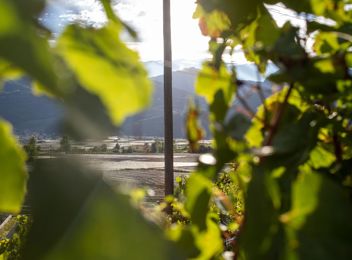
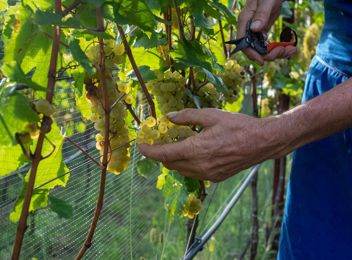
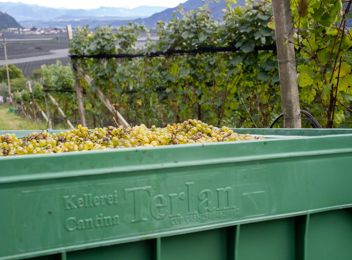
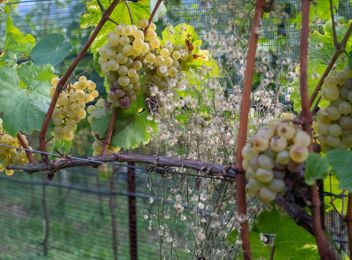
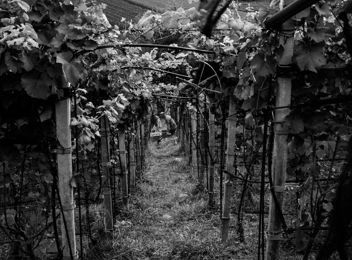





When the Sparerhof sommelier skillfully opens a bottle of wine, the speed with which he removes the capsule and cork can quickly make you forget about everything that went into producing such a beautiful glass of Terlaner classico. Vines grow grapes, which make wine; simple. An equation we all know. Ignorant of all the effort made during the harvest season to produce a bottle of wine. So, let's start from the beginning: what actually happens? How does a grape harvest actually work? From the cozy wine cellar, the Sommelier's comfort zone, he makes his way to the vineyard. The principle is simple. Cut the grapes from the vine with grape shears, place them in the “Wimmkibbel” (nothing but a humble basket) and from there into a large crate. Repeat until no more grapes remain. Vine by vine, row by row, plot by plot, hundreds, thousands of times throughout South Tyrol.
It may seem trivial, and indeed it is, but it still requires practice and understanding. Anyone can pick grapes and anyone can let them ferment; but to make great wine, the details matter. The special sauce is the grape itself. This year, the ripening period and a window of rain coincide. There is a tension in the vineyard. Where there is rain this late in the season, there is a risk of rot destroying the harvest. These are delicate and critical days, but with a little luck, a window opens some sunshine creates just the right conditions for the harvest. The window is brief. We have to work quickly and precisely. Our harvest, Chardonnay, ripens early. Chardonnay has thinner skins and smaller berries, making the grape variety more susceptible to rot.
Although we were lucky and able to harvest ripe and healthy grapes, the microclimate of some rows meant that, due to a variety of coincidences, the vines were laden with both healthy and infected grapes. The infected ones have to be removed. A task that requires sensitivity and careful separation, that cannot leave the berries damaged. Gentle, and yet quick work — therein lies the art.
In addition to gentleness, resilience is also required. The work is strenuous and demanding. Sloping terrain, differences in altitude, constant climbing and descending. It takes its toll on the back and knees, and roughens the hands. Focus is essential; the same work must be carried out with the same precision for hours on end. If wine consists of 85% water, then 1% must be from the sweat of hard work.
The work continues throughout the day. Only with the fading light does the harvest come to an end. Fom the tractor, it is onwards to the cellar. This is critical, any mistakes during harvest can lead to the juice of damaged berries triggering fermentation here. Once again, speed is of the essence. But for the Sommelier, this is where he leaves the grapes. The next time he’ll see them, they will be inside of a bottle.
In the winery's cellar, fresh challenges await the cellar masters. And while legend has it, that the concierge knows all the employees of the Terlan winery by name, it is doubtful that he knows all the steps involved in producing a bottle of Terlaner classico.
We are all familiar with the term “supply chain”, at the very least, since COVID. A bottle of wine requires a lot of intermediate steps, from the wine to the bottle itself: labels, corks, and capsules. And while it would certainly be more exciting to take a look at the production process, we must not forget all the other work that goes into a bottle of wine. From the supplier (in our case, truly zero kilometers) to accounting.
But before we can even think about the logistics, a year has to pass in the vineyard. The harvest is just one of many steps that has to be taken in the beforehand. Certainly, it is the most critical. But without careful work throughout the year, only meager spoils await come harvest time.
And while we are all delighted about a superb 2025 vintage, with the harvest safely stored in the cellar, we will only be able to taste the fruits of our labor in a few years. By then, when we look at the label and the year 2025, we will have forgotten all about the hard work on the slopes of the vineyard. Long forgotten will be the rain front and hailstorm induced anxiety we went through.
In the end, a vintage on the label means much more than the harvests year. Now at last, we truly have an idea of how much work went into creating it. Tasting the fruits of labor is much more relaxing than the labor. So when we read: Terlaner classico 2025, we know. A good year, with its challenges and hard work. And perhaps, just perhaps, a drop of the Sommelier's sweat.
Cheers. Stay tuned.
